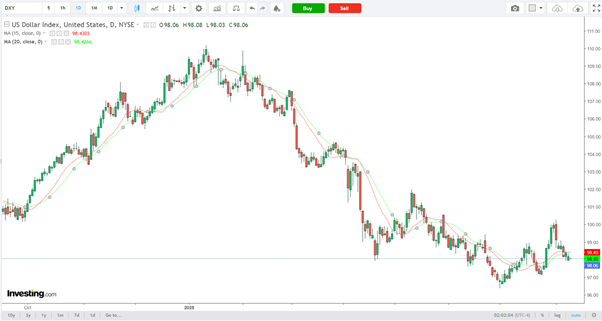In the intricate world of currency trading, the US Dollar Index (DXY) serves as a crucial barometer for the value of the United States dollar against a basket of foreign currencies. As of recent trading sessions, the DXY finds itself at a pivotal point, oscillating around the 98.06 mark. This is just shy of the intersection point of its 15-day and 20-day Simple Moving Averages (SMAs) that stand at 98.43, indicating a convergence of short-term sentiment. The coming together of these averages – the 15-day depicted in red, and the 20-day in green – signifies a phase of price consolidation that comes on the heels of a marked decline from the lofty peaks of approximately 111.00 witnessed in mid-2024.
The trajectory of the DXY has been a topic of keen interest among investors and traders alike. Following an extended period of depreciation, there has been a noticeable struggle within the index to foster a robust upward momentum. Particularly, the DXY’s attempt to breach and sustain above the psychologically significant 100.00 level has met with adversity, rendering it a formidable medium-term resistance for the currency index.
Insight into Technical Perspectives:
- The apparent stagnation of the 15-day and 20-day SMAs, as they remain relatively flat, underscores a prevailing uncertainty or a lack of a distinct directional drive in the market.
- A narrow trading range, delineated by 97.80 and 98.90, adds to the narrative of market indecision, capturing the essence of the tug-of-war between bulls and bears.
- Despite these fluctuations, the overarching sentiment leans towards the bearish spectrum, motivated by the continuation of a downward trend initiated in mid-2024.
Core Trading Levels to Watch:
- The immediate hurdle for the DXY lies at 98.90, closely followed by a more significant resistance zone around 99.50, highlighted by a prior short-term swing high.
- On the reverse side, support emerges at 97.80, acting as the foundational floor of the current trading range, with a more critical breakdown level identified at 97.00.
Analytical Outlook:
A neutral-to-bearish bias encapsulates the current sentiment surrounding the DXY. This outlook persists as long as the index navigates below the critical junctures of 98.90 to 99.50. Should these resistance levels give way, it may usher a phase of bullish revival, potentially carving a path towards the sought-after 100.00 territory. Conversely, a failure to ascend beyond these barriers could see the DXY retract towards 97.80 and, in a more bearish scenario, to the 97.00 threshold.
For retail traders and market enthusiasts, the evolving dynamics of the DXY warrant careful observation for signs of a breakout in either direction. Such movements could either underscore a revitalization of the US dollar or serve as a precursor to extended declines, particularly in relation to its counterparts.
Contextual Backdrop:
The US Dollar Index’s journey through financial landscapes is a story woven with multiple threads – encompassing economic policies, geopolitical events, and shifts in global investment sentiment. Born in the aftermath of the Bretton Woods Agreement’s collapse, the DXY was conceptualized as a means to measure the dollar’s performance against a basket of leading foreign currencies, including the Euro, Japanese Yen, British Pound, Canadian Dollar, Swedish Krona, and Swiss Franc.
The Index’s movements, especially its decline from the zeniths of 111.00 in 2024, prompt a reflection on several underlying factors. These include the Federal Reserve’s monetary policy stance, varying strengths of the economies represented within the DXY, and overarching market sentiments driven by global events.
Forging Ahead:
As the global economic environment remains in flux, with central banks navigating through the challenges of inflation and economic recovery, the DXY’s trajectory becomes all the more salient. Investors and traders continue to parse through data, speeches from central bank officials, and economic indicators to gauge future movements of the US dollar.
In essence, the US Dollar Index finds itself at a crossroads, encapsulating the complexities and nuances of global finance. Its current stance below the convergence of significant moving averages serves as a testament to the unpredictable nature of markets, reminding participants of the critical interplay of technical and fundamental analyses in charting the course of currencies on the world stage.


